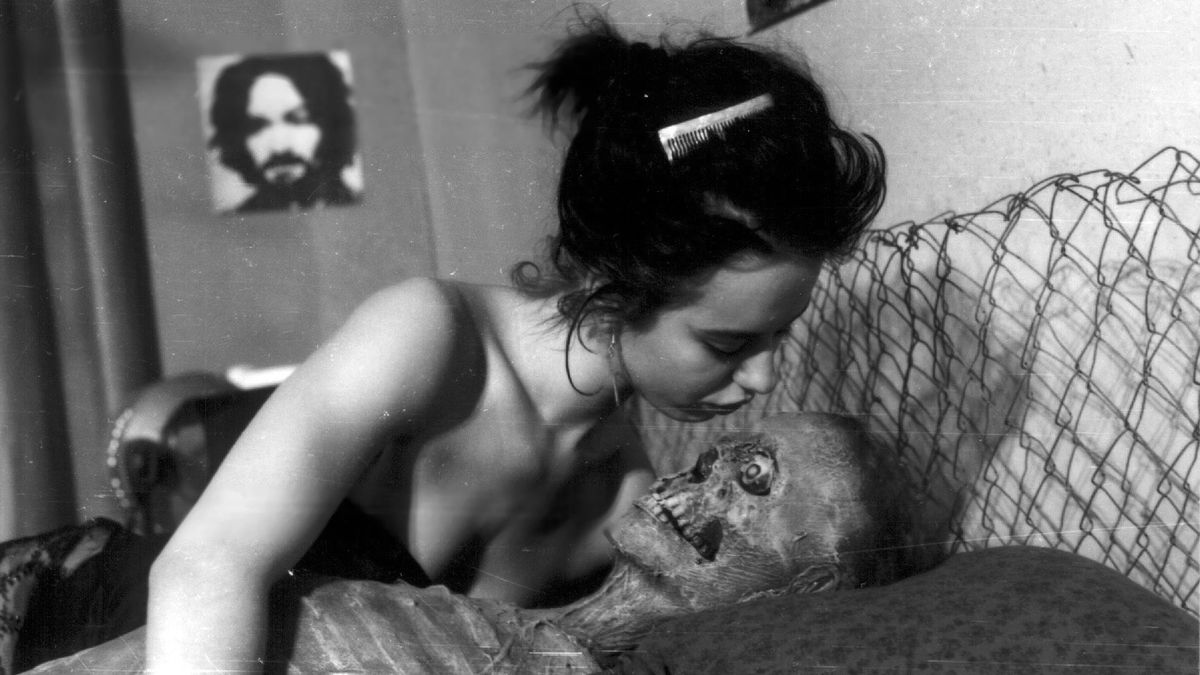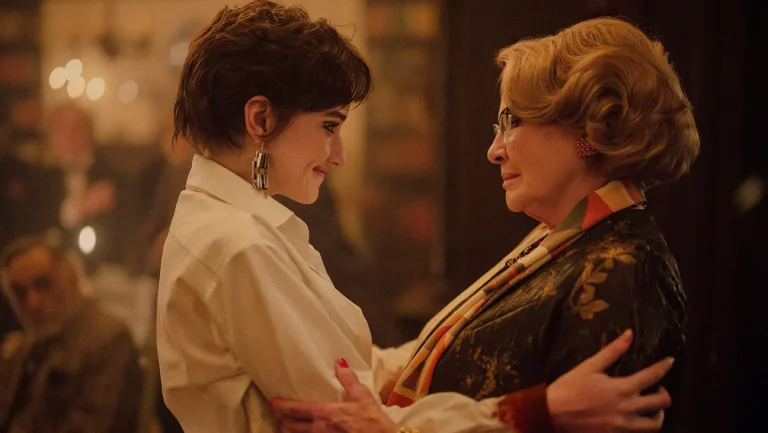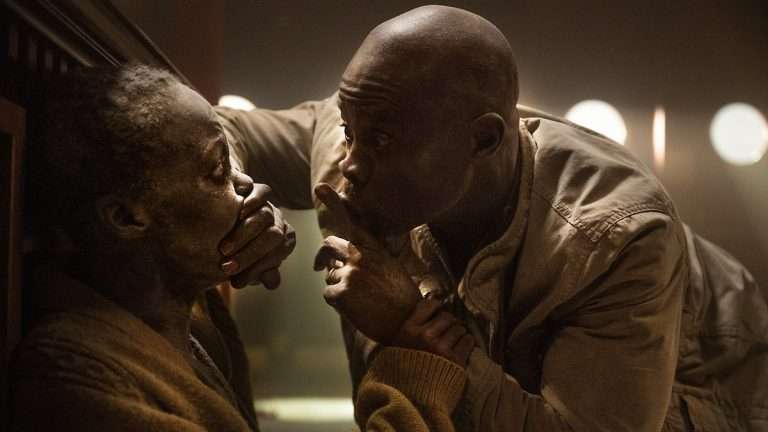Nekromantik (1988) Movie Ending Explained And Themes Analysed: If the thought of watching another cliched romantic film with your significant other this Valentine’s Day bores you, a German exploitation film from 1988 might just whet your appetite for something distinctive. Nekromantik, the aforementioned film, is described by its director Jörg Buttgereit as a love story. While Buttgereit’s assertions are unironic, the notoriety behind Nekromantik would scoff at the director’s romantic statement about his feature. Judging from its title alone (a portmanteau of the words ‘necrophilia’ and ‘romantic’), it is not hard to see why the film has become one of the most censored, banned, and bootlegged films of all time.
Essentially, the film is what it says it is—the story of a man who gets sexual and romantic fulfillment from having sex with corpses. If you and your significant other have the guts (pun intended) to digest the morbidity of this premise, consider Nekromantik to be your date night feature this year!
Like many of the reviews of Nekromantik online, it is very easy to adopt a sarcastic and humorous tone while talking about this infamous film. After all, Buttgereit checks all the boxes to include the most messed up stuff in his project—necrophilia, perversions, animal cruelty, and murder! Thanks to its exploitative storyline, Nekromantik has been known more for its notorious premise than for the film itself. There are hundreds of listicles online that have frequently cited Nekromantik and its sequel as being the most shockingly fucked up films ever made. Although the film is undoubtedly outrageous, this discourse has come at the expense of the film’s more interesting thematic underpinnings. This article explains the film’s controversial ending and examines the more pressing concerns of the film. As always, here is a spoiler alert!
Nekromantik (1988) Movie Plot Summary & Movie Synopsis
Nekromantik follows Rob Schmadtke (Bernd Daktari Lorenz), a cleaner employed by Joe’s Street Cleaning Agency. Along with his colleagues, Rob’s typical job revolves around cleaning up after gruesome crime scenes. On the surface, Rob is an introverted everyday working-class guy who lives in a one-bedroom apartment with his girlfriend, Betty (Beatrice Manowski). But oblivious to everyone around them, Rob and Betty harbor a morbid interest in everything related to the dead—their apartment is full of mason jars and beakers containing various preserved body parts, which Rob stealthily manages to steal from the corpses.
One day Rob returns home with another souvenir from one of the crime scenes. As Betty bathes in blood-soaked water, Rob watches a television program about a psychologist explaining how several phobias can be cured by desensitization. Seeing the explanation, Rob is transported back in time. He has a vision of a man (probably his father) brutally killing off a bunny and dismembering it (this vision from the past has great narrative importance, as later discussed).
Following this introduction to Rob’s life—we are taken to another sequence involving a rich man drinking beer in his garden and shooting birds from his gun. Just as the man is pointing his gun at one of the feathered creatures, he accidentally ends up shooting a gardener picking apples from a nearby tree. Afraid that the law will punish him for this homicide, the man quietly takes the gardener’s corpse and dumps it in a pond. After an unspecified period of time, Rob and his colleagues find the decaying skeleton of the gardener. Rob’s supervisor Bruno (Harald Lundt), entrusts him with the responsibility of taking the corpse to the laboratory. But Rob (after a period of hesitation) decides to take the dead body back to his apartment.
Betty is elated to receive such a ‘gift’ from her boyfriend—and what follows next is the most uncomfortable sex scene ever filmed in cinema history. Rob uses a metal rod to substitute for the penis of the corpse, and Betty even puts a contraceptive on the rod-cum-penis (safe sex always, folks!) The trio then engages in a threesome, caressing and fondling the gardener’s corpse—all this is filmed with innocuous romantic music in the background. After finishing, the duo hangs their skeletal partner on the wall so that the dripping blood from his body is collected in utensils on the floor.
The next day, Rob is late for work at the agency. Bruno, already exasperated by the stinking smell from Rob’s locker, complains about Rob to the company’s manager, who fires him. Meanwhile, Betty is having a gala time in the apartment with her corpse lover—reading a novel to it as if it were an animate being. A dejected Rob returns to the apartment and informs Betty about being fired from his job. Betty is horrified at this news and castigates a timid Rob for not standing up for himself. She is stressed that she won’t have any more corpses to sleep with as the gardener’s body will soon decay, and Rob’s unemployment will prohibit him from gaining access to other crime scenes.
Following this fiasco, Rob decides to get a cat to appease Betty. But when he returns to the apartment—Betty has fled with the corpse. After Betty’s departure, Robert sinks into depression and brutally kills the cat he had brought for his girlfriend. Rob then proceeds to take a bath while rubbing the bloody insides of the cat all over his body.
Left jobless and isolated, Rob has nothing better to do, so he heads over to the local cinema hall, which is screening an erotic slasher flick. The premise of the film involves a woman being chased by a maniacal killer. The killer ties the woman before stripping her and stabbing her breasts. Despite such a violent premise of the film, the audience present seems numb to the brutality and misogyny of such depiction. Some audience members are even enjoying it, while others are turned on by the rape onscreen. Rob leaves the film midway, returns to his desolate apartment, and takes some pills to sleep. That night Rob has a weird dream where he himself has turned into a corpse and is greeted by an angelic woman in white. The woman gifts him a corpse head, and the two of them begin to play joyfully with the head.
When Rob wakes up, he goes to a redlight area and hires a sex worker. At his request, the sex worker accompanies him to a graveyard, and Rob suggests a tombstone to have sex on. Despite his efforts, Rob is unable to get his penis erect, prompting the sex worker to mock him. Enraged by her scorn, Rob strangles the sex worker to death and then has sex with her dead body—this time being able to finish. The following day, the local undertaker finds Rob and the dead woman. Before the undertaker has the time to react, Rob snatches his shovel and beheads the man.
Rob then spends the rest of the day in an open green field, madly dancing and running about the space. After this, a seemingly depressed Rob returns to his apartment and proceeds to stab himself with a kitchen knife. As he kills himself, Rob has an orgasm and ejaculates repeatedly—this suicide footage is again intercut with the earlier killing of the rabbit but played in reverse. In this reverse sequence, the dismembered rabbit is brought to life and is restored to its animated, lively state.

The film’s final shot is of Rob’s freshly dug grave. Before the film cuts to the credits, we see a woman beginning to dig the grave to retrieve Rob’s body—setting the doors for another necrophiliac sequel.
Nekromantik (1988) Movie Themes Analyzed
What Does The Rabbit Symbolize?
Even though the brutal sequence of the skinning of the rabbit only plays twice in the film (once as it is and then in reverse), it has great thematic significance in the film—both narratively as well as symbolically.
On a narrative level, the skinning sequence plays off as a memory from Rob’s past. As a child, it is inferred that Rob had witnessed the brutal slaying of his bunny, most likely done by his father. The killing of his pet rabbit (an animal largely deemed innocent and adorable in our popular imagination) deeply scarred Rob’s psyche and perhaps contributed to his necrophiliac tendencies. Psychoanalyst Sigmund Freud argued how childhood experiences are fundamental in shaping our personality and desires—this view is further confirmed by the psychologist in the film whose program Rob is watching.
The psychologist mentions how our repeated exposure to violence can ultimately end up desensitizing us to the object of our fears. In Rob’s case, he has become so desensitized to the sight of corpses and death that his desensitization has ultimately transformed into a perverted love for death and decay. Just like a woman who had arachnophobia but later developed an affinity and love for spiders after being exposed to them. Similarly, Rob has transformed his trauma into a perverted longing for the dead.
The final sequence of Rob’s suicide, where he ejaculates as he kills himself, can be interpreted in two ways. On a more fundamental level, it is Rob’s way of transferring his necrophiliac tendency upon himself—achieving the ultimate orgasmic pleasure through this sadomasochistic endeavor of converting himself into a dead body. But film scholar Linnie Blake in her essay “Jörg Buttgereit’s Nekromantiks: Things to do in Germany with the dead,” argues how the final sequence, with its interplay of the reverse rabbit footage, has a more profound implication.
Blake argues that by killing himself, Rob purges himself of his childhood trauma—exorcising the demons that led him to necrophilia. That is why in the sequence, the beloved rabbit from Rob’s childhood comes back to life. Similarly, David Kerekes (the writer of Sex, Murder, Art: The Films of Jörg Buttgereit) mentions how by playing the rabbit footage in reverse, the film restores Rob to his pre-traumatic stage—bringing back what was destroyed and healing old wounds.
But apart from this narrative significance, the rabbit also has a symbolic association. Rabbits are considered symbols of reproduction, sex, and copulation (the popular phrase being ‘breed like rabbits’)—which also happens to be one of the film’s central themes. The mauled rabbit then evokes both sex and death—two themes that director Jörg Buttgereit has stated are the film’s pressing concerns.
The Meta-Commentary on Violence Onscreen
Although on the surface, Nekromantik seems like a typical exploitation affair made solely to scare and provoke, director Jörg Buttgereit’s intention runs deeper than to deliver mere shock value. Linnie Blake had mentioned how the film was released during a time when the political climate in Germany was highly conservative—and Buttgereit sought to challenge such a sanctimonious morality. Even though the film roots necrophilia in a traumatic childhood incident, Buttgereit never passes any moral judgment on the practice. Rob and Betty are an everyday couple, except they have a fetish for everything related to death. On the other hand, Buttgereit targets other normative members of our so-called respectable society.
For instance, while Rob and Betty use the gardener’s dead body for their pleasure, a rich man actually brought the gardener to this grievous state by accidentally shooting him. Blake, in her essay, draws attention to the fact that the gardener was killed by one of the respected members of society. The man not only committed the homicide but also evaded the eyes of the police and the law. Through this sequence, Buttgereit shows how the everyday man is as morally debauched (if not more) as the perverted necrophiliacs in German society.
Another sequence where the film takes a jibe at this hypocrisy is when Rob goes to the cinema to view an exploitative slasher flick. Even though the slasher film features gratuitous violence on a woman’s body, the audience members are utterly passive to such images—having been desensitized to such a degree that the rape-murder sequence becomes a source of pleasure for the audience in the theatre—with some members even turned on by the premise.
With this sequence, Buttgereit inserts his meta-commentary on the onscreen violence prevalent in filmic images. Even though the audience enjoys blood and gore onscreen, it is likely to find the premise of having sex with corpses disgusting and morally profane. By underlining this dichotomy in our reception of taboos, Buttgereit poses an important question: Who gets to decide what is suitable for viewing and what is sacrilegious? One person’s taboo will always be another person’s desire or fetish.
Linnie Blake expands further on this theme of desensitization by arguing how the film sought to jolt German society out of its horrific past. Following the nightmarish events of the Holocaust, German society had seemingly become complacent and desensitized to any sort of violence. By revoking provocative images in his film, Buttgereit sought to shock and re-sensitize society and force it to confront its dark past. Rather than bury the skeletons of the past, Buttgereit invokes German society to retrieve them from the grave. One has to face the past, even if it harbors an event as horrific and stomach-churning as the Holocaust.
Also, Read: Why Lesley From Birdman Could Be Betty From Mulholland Drive?
Nekromantik (1988) Movie Links: IMDb, Rotten Tomatoes
Works Cited
1. Blake, Linnie. “Jörg Buttgereit’s Nekromantiks: Things to do in Germany with the dead,” in Mathijs, Ernest (ed.), Alternative Europe: Eurotrash and Exploitation Cinema Since 1945.
2. Kerekes, David. Sex, Murder, Art: The Films of Jörg Buttgereit.
3. “Nekromantik Director Jörg Buttgereit Interview.”
https://www.youtube.com/watch?v=eBRuvgV_Wx0&ab_channel=RedCarpetNewsTV
4. “Q&A with Jörg Buttgereit.”
https://www.youtube.com/watch?v=rrCz_2aKzGs&ab_channel=OffscreenFilmFestival
**************************


![[Watch] Underwater Trailer : Kristen Stewart Goes Ellen Ripley In Upcoming Survival Film](https://79468c92.delivery.rocketcdn.me/wp-content/uploads/2019/08/underwater-trailer-768x352.jpg)



